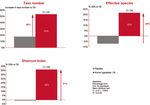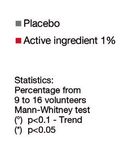MICROBIOME New findings on scalp microbiota help tackle scalp conditions
←
→
Page content transcription
If your browser does not render page correctly, please read the page content below
MICROBIOME
New findings on scalp microbiota help tackle scalp conditions
Active ingredient based on research insights promotes a healthy
scalp and microbial diversity
SABRINA LEOTY-OKOMBI1*, ALLISON GARLET2, CÉCILE KALEM1, NICOLAS STEFANO DEL BENE2, GEORGE KRITIKOS3,
CATHERINE BONNAUD-ROSAYE1, WENDY CHAN2, PHILIPPE MOUSSOU1, VALÉRIE ANDRE-FREI1
*Corresponding author
1. BASF Beauty Care Solutions SAS
2. BASF Corporation, Tarrytown, United States
3. BASF SE, GDB/BA - Digitalization in R&D, Ludwigshafen, Germany
Abstract: Keywords:
Hectic lifestyles as well as environmental influences negatively modify the physiological parameters of the scalp,
making hair and scalp concerns more prevalent. In a new metagenomic study, researchers explored the
• Scalp microbiome
disruptive influence of sebum on the scalp’s fragile microbiotic balance. The analysis confirmed that the diversity • Oily scalp
of the microbiota is lower on an oily scalp than on a normal scalp. They also identified six beneficial species with conditions
a particularly high occurrence on a normal scalp and a noticeably reduced presence on oily scalps that were • Sebum
assumed to promote overall scalp health. In response, a new active ingredient based on Sarcosine was • Prebiotic effect
developed. The active showed to significantly increase the diversity of the scalp’s microbiota and to boost
• Sarcosine
recolonization with the six strains of beneficial bacteria. Besides this prebiotic effect, studies have demonstrated
that sarcosine inhibits 5-α-reductase, lowering the level of scalp sebum. The results on microbiota and sebum • Microbiome
secretion make sarcosine a perfect ingredient for the improvement of oily scalp conditions. • Peer Reviewed
In an increasingly urbanized world, our hair and scalp are scalp. Based on these findings, a new active ingredient was
faced with a multitude of environmental influences that developed. Taking the INCI name Glycerin (and) Water (and)
can negatively impact their beauty and vitality. Consumers Sarcosine (Glycerin 82%, Sarcosine 6.3-7.7% and Water sqf
are therefore seeking solutions that help combat the side 100), the active ingredient is based on Sarcosine, an amino
effects of our modern world – especially since there is a acid derivative found naturally in the human body. It is a
growing awareness that stress and pollution play a role in precursor of glycine, an amino acid essential for building major
the impairment of scalp health and ultimately the beauty skin macromolecules such as elastin and collagen. Both in
and vitality of our hair (1). A high stress level increases the vitro and in vivo trials have confirmed the ingredient’s ability
activity of the sebaceous glands in the hair follicles, leading to soothe and purify the scalp by reducing the production of
to an overproduction of sebum. The scalp therefore becomes sebum and replenishing scalp microbiota.
irritated and hair appears greasy or oily. At the same time,
urban living can cause dust or pollution to form deposits on RESULTS AND DISCUSSION
the scalp and hair fibers. Affected people experience itchiness Healthy vs. oily scalp microbiota
and prickling or even a burning sensation and pain. Ultimately, Scientific literature had already shown that skin microbiota
the accumulation of dust, pollution, and sebum changes the diversity decreases in oily areas of the skin like the forehead (6).
physiological parameters of the scalp – and thus disrupts the A new metagenomic study has now confirmed that the same
fragile balance of the microbiota. (2) (3) holds true for some bacteria groups on an oily scalp. The
study was conducted on 40 volunteers with a high level of
In the past few years, skin microbiota has become an essential scalp sebum and 28 volunteers with a normal (non-oily) scalp
ally of the personal care industry. Intensive research done sebum level. According to a species presence and absence
in this field has revealed that the skin’s surface is home to analysis, participants with a normal scalp showed a higher
millions of microorganisms such as bacteria, viruses and fungi diversity of Staphylococcus, Streptococcus and Actinomyces.
that act as a protective shield and help ward off colonization At the same time, they showed a higher abundance of some
by pathogenic microorganisms (4). Understanding the Staphylococcus, Streptococcus, Actinomyces and Veillonella
interactions between the skin and its microflora are the basis species and a higher abundance of Rothia aeria. The number
for developing cosmetic active ingredients that help preserve of aerobic bacteria seemed to be higher compared to the oily
skin health and beauty. What has been virtually unexplored scalp group, which can presumably be attributed to the lower
until now, however, is that a balanced microbiota is not only sebum levels characteristic for a healthy scalp. Volunteers
relevant for our skin, but plays an important role for the scalp, with an oily scalp, by contrast, exhibited an abundance of some
too. Scalp discomfort, for instance, has been correlated lipophilic and anaerobic bacteria, which were hypothesized to
to the presence of some bacteria like Hymenobacter and be thriving on the sebum richness.
Deinococcus (5).
Identifying bacteria strains that support scalp health
To further explore the scalp microbiota’s role and potential, In their study, the researchers focused on six bacteria
researchers conducted a metagenomic study in which they species with a particularly high occurrence on a normal
compared the microbiota of a normal scalp to that of an oily scalp and a noticeably reduced presence on an oily scalp
28 HPC Today vol. 16(2) 2021MICROBIOME
that were assumed to contribute to overall scalp health This stimulation in the growth of advantageous bacteria
based on their properties as described in literature: Rothia represents the product’s prebiotic effect of on the scalp.
aeria, Staphylococcus warneri, Staphylococcus pasteuri,
Streptococcus australis, Veillonella parvula and Actinomyces
odontolyticus.
The gram-positive bacterium Rothia aeria is capable of
producing catalase, an important enzyme in protecting cells
from oxidative damage by a reactive oxygen species (7).
Staphylococcus pasteuri produces pasteuricin, an
antimicrobial peptide (AMP) able to inhibit Staphylococcus
aureus growth (8). Staphylococcus warneri is another
commensal bacterium producing the AMP warnericin,
which plays a role in combating parasites (9). Streptococcus
australis, meanwhile, is known to antagonize Streptococcus
mutans (10). According to literature, Veillonella parvula is useful
against inflammation and fungal expansion in dandruff (11).
Finally, Actinomyces odontolyticus is a facultative anaerobe
known to produce super oxide dismutase, a naturally occurring
antioxidant enzyme (12).
Resetting the scalp microbiome
In a metagenomic analysis, researchers evaluated the effect
of the newly developed active ingredient Glycerin (and) Water
(and) Sarcosine on bacteria abundance on an oily scalp. Figure 2. Comparison of microbiome before and after placebo and Scalposine-
A mask formula containing a 1% active ingredient was tested based active ingredient use for 28 days on volunteers with oily scalp.
during a one-month placebo-controlled clinical study that
involved two groups of participants (Placebo: n=12 / Sarcosine: Keeping sebum production at bay
n=17). After 28 days of treatment with the Sarcosine-based Besides the proven prebiotic effect on the scalp microbiota,
active ingredient, a significant increase in the relative abundance Sarcosine showed the ability to reduce sebum secretion.
of more than 20 bacteria was observed. In the placebo group, In an in vitro trial, sarcosine at a dose corresponding to
the treatment did not induce a significant shift in the abundance the active ingredient at 0.7% effectively reduced the gene
of scalp microbiota. Unlike the placebo, the active ingredient expression of 5α-reductase 1, the enzyme initiating the
also led to an increase in scalp microbiota diversity, as shown process of sebum production, by as much as 77% (Figure 3).
by the changes in three different descriptors of diversity: A – This enzyme is responsible for converting testosterone into
taxa number (+53%), B – Effective species (+22%), and C – dihydrotestosterone (DHT), which then activates specific
Shannon Index (+36%) (Figure 1). receptors in the sebaceous glands. Furthermore, human skin
explants incubated in the presence of Sarcosine showed a
significant reduction in the transformation of testosterone
into DHT. An inhibition of 36% was obtained when Sarcosine
was used in a culture medium at a dose corresponding to the
active ingredient at 0.14% (data not shown). These results are
key properties for inhibiting the overproduction of sebum on
the scalp.
Figure 1. Effect of Sarcosine-based active ingredient on scalp
microbiota diversity.
Furthermore, particularly those six species identified earlier as
being beneficial for a healthy scalp increased in number from
Figure 3. Effect of the active ingredient at 0.7% on
treatment with the active ingredient: Staphylococcus warneri,
5α-reductase 1, the enzyme responsible for the
Staphylococcus pasteuri, Streptococcus australis, Veillonella transformation of testosterone into DHT.
parvula, Rothia aeria and Actinomyces ondontolyticus (Figure 2).
vol. 16(2) 2021 HPC Today 29MICROBIOME
Sarcosine’s inhibiting effect on sebum production was of product efficacy on scalp soothing (after first use, D14 and
confirmed in a placebo-controlled clinical study performed on D28) by assigning a rating between 1 (agree strongly) and 6
two groups of participants (Placebo: n=12 / Sarcosine: n=17) (disagree strongly).
exhibiting an oily scalp (sebumeter > 120 μg/cm2). A mask
formula containing the Sarcosine-based active ingredient In vitro measurement of 5α-reductase 1 gene expression
at 1% significantly reduced the level of sebum, showing a Keratinocytes at confluence were incubated for 24 hours
reduction of 20% vs. the placebo (Figure 4). As sensitive with Sarcosine at a dose equivalent to Glycerin (and) Water
scalp has been associated with excessive sebum and lower (and) Sarcosine at 0.7%, and KSFM medium alone as an
microbial diversity. The effects of Sarcosine were therefore untreated control. RNA was extracted with “SV 96 Total RNA
expected to also contribute to the improvement of scalp Isolation System” (Promega) and diluted in RNAse-free water.
comfort and health (13). This assumption was confirmed in A PCR reaction mixture containing primers of actin and/or
a self-assessment: 82% of study participants reported an 5α-reductase was added; the resulting mixture underwent
immediate soothing effect on the scalp. 50 amplification cycles in an Opticon thermocycler (MJ
Research). Results were first normalized to the expression
of the actin gene and expressed as a mean percentage ± SD
of quadruplicate quantification compared to the untreated
control, which was standardized to 100%. The statistical
analysis was done using one-way ANOVA and Dunnett’s test,
with a threshold of significance set to 5% (p 120 μg/cm2); 28 volunteers had a normal (non-
oily) scalp (sebumeter 60-120 μg/cm2). Scalp microbiota was
sampled through swabbing. Microbial DNA was extracted, and
residual host DNA removed using a QIAamp DNA Microbiome
Kit (Qiagen). Whole metagenome sequencing libraries were
prepared and submitted to paired-end sequencing on the
HiSeq 3000. For taxa analysis, raw reads were cleaned up
using BBDuk, and human reads were removed using Bowtie2
(sensitive to hg38). All other reads were processed using
MetaPhlAn2 to generate a taxonomy abundance profile.
The presence of a species in a sample was reported when its
relative abundance value was above 10-6. Relative abundance
values were normalized using quantile normalization and
log10 transformation.
In vivo and in vitro effect of Sarcosine-based ingredient on
an oily scalp
A double-blind randomized placebo-controlled study was
conducted to evaluate the efficacy of the active ingredient at
1% in a mask formula. Volunteers applied the treatment for
28 days at least three times a week; 12 volunteers applied
a placebo formulation, while 17 applied the formulation
containing the active ingredient. Taxa analysis was done using
the same experimental setup as for the comparison between
a normal and oily scalp. Sebum secretion was measured with
a Sebumeter (Courage and Kazaka) at D0, D14 and D28, with
a decrease in the Sebumeter value reflecting a decrease in
scalp sebum. In addition, a self-assessment was performed
30 HPC Today vol. 16(2) 2021MICROBIOME The statistical analysis was done using a Mann—Whitney U baikonurensis sp. nov. and Arthrobacter russicus sp. nov., test, and the significance threshold was set at 5% (p
You can also read
























































